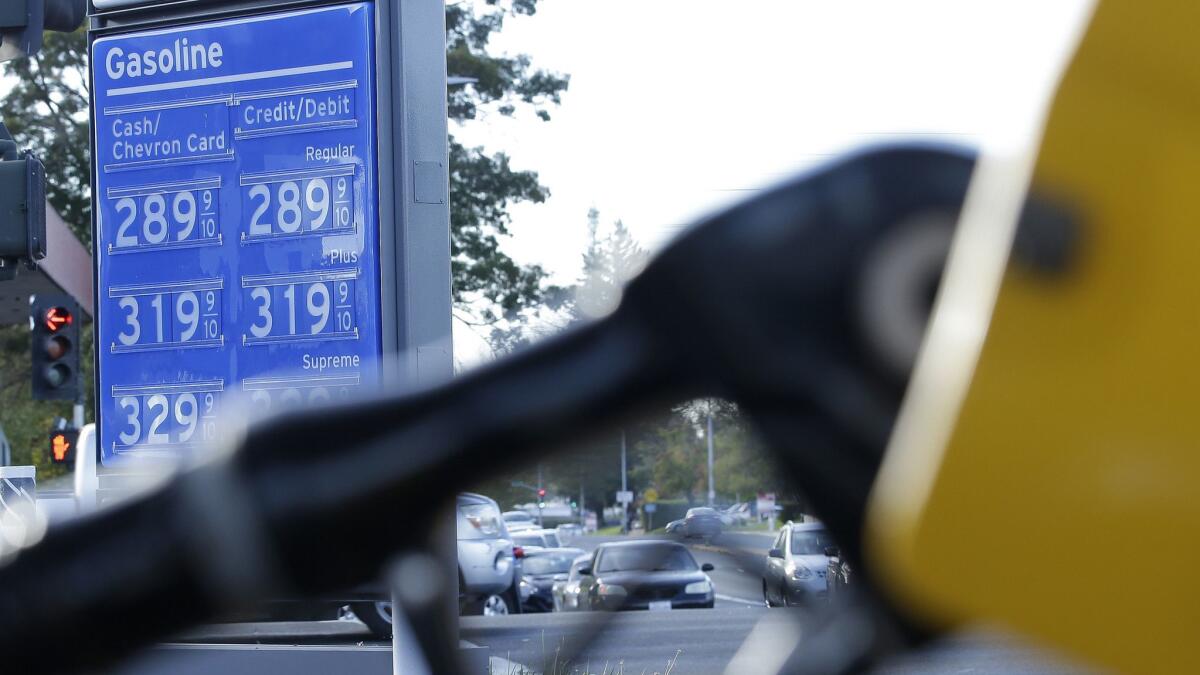Op-Ed: Forget the gas tax. Let’s get to the bottom of California’s 22-cents-a-gallon mystery surcharge

- Share via
Why are California’s gasoline prices so much higher than those of the rest of the country?
The advocates for Proposition 6 will tell you it’s because of the gas-tax increase passed in Sacramento last year.
Part of the difference is higher taxes, but that’s not all there is to it. Selling and refining gasoline in California simply costs more than in other states. But there’s also a mystery surcharge on gas in the Golden State: In the last few years, the price gap has jumped higher than costs and taxes can explain.
So far this year, California’s gas price has been about 80 cents a gallon above the average of all other states. Higher state gas taxes account for about 23 cents of the difference. An additional 3 cents on average is due to local sales taxes, which vary by county.
Then there are the fees to address environmental impacts, mostly climate change. The state’s cap-and-trade program on greenhouse gases has added 12 cents a gallon in 2018, and our “low carbon fuel standard” has pushed the cost up by about 8 cents. Finally, we pay 2 cents to clean up old gas station sites where fuel leaked into the soil.
We expected prices to return to normal levels after the refinery resumed production. They didn’t.
Add that up and Californians are paying about 48 cents a gallon more to state and local authorities than the average American. That’s real money considering that we use about 1 gallon of gasoline per person per day.
At least that 48 cents buys us some real benefits: It goes to repairing roads and bridges, building needed new infrastructure for our rapidly expanding economy, and helping low-income California families afford energy. A bit of it, it’s true, goes to more controversial projects such as high-speed rail (about 3 cents), but the majority pays for bread-and-butter public services that we use every day.
But what about the rest of that extra 80 cents a gallon? A slice of the remaining difference pays to refine oil so that it meets California’s cleaner-burning gasoline formula, adopted in 1996. Most analysts think that the cleaner formulation adds no more than 10 cents to what we pay at the pump.
That leaves the mystery surcharge, which is 22 cents a gallon this year. I’ve broken down the cost of gas annually for more than a decade: The surcharge averaged 2 cents from 2000 to 2014 and was never more than 12 cents in any of those years. But everything changed in 2015.
As chair of the Petroleum Market Advisory Committee to the California Energy Commission, I watched gas prices skyrocket after a refinery explosion in Torrance in February 2015. The committee expected tighter supply to drive up prices, as it had done after previous refinery accidents. But we also expected prices to return to normal levels after the refinery resumed production. They didn’t. For the rest of the year, the mystery surcharge was about 48 cents a gallon.
What was more disturbing was that it continued at unprecedented levels in 2016 (29 cents) and 2017 (27 cents), long after the Torrance refinery was back at full production.
Our 22-cent mystery surcharge this year is nearly twice as much as the 12-cent gas-tax increase, and yet no one is trying to abolish the surcharge. Since February 2015, it has cost Californians more than $17 billion, or about $1,700 for a family of four. And none of those dollars have gone to building infrastructure or helping poor families.
Enter the Fray: First takes on the news of the minute from L.A. Times Opinion »
Lawmakers thanked the PMAC for our final report on the mystery surcharge in September 2017, and then promptly went back to fighting about gas taxes.
Looking at gasoline prices nationwide over the last four years provides clues that may explain some of the mystery. The surcharge doesn’t come in at the production end of gasoline. The commodity price of California gas spiked in 2015, after the refinery fire, but it dropped again in 2016. Since then, the commodity price differential with the dirtier fuel used elsewhere has been around 10 cents, lower than in any year of the previous decade.
Instead, the surcharge shows up between the refineries and our gas tanks, in the distribution and retailing network. Many characteristics of these sectors suggest that California lacks the competitive pressure of other states. Far more stations here are owned by refiners or have long-term contracts that give the refiners significant control over gas prices. Less gasoline is sold through off-brand stations such as Costco or Safeway, which means they put less pressure on the major brands. In California, the price difference between majors and off-brands averages 23 cents per gallon, according to data from Gas Buddy. Elsewhere in the country, that difference is only 7 cents. Those facts don’t nail down the cause or the exact beneficiaries of the mystery surcharge, and they don’t identify policies that would reduce it. To get to those answers would require a serious and well-funded investigation by the state.
Instead of voting against a gas tax that benefits us all, tell your representatives in Sacramento that it’s time to solve the gas-surcharge mystery.
Severin Borenstein is a professor at UC Berkeley’s Haas School of Business and faculty director of the Energy Institute at Haas, where he maintains an energy blog.
Follow the Opinion section on Twitter @latimesopinionand Facebook
More to Read
A cure for the common opinion
Get thought-provoking perspectives with our weekly newsletter.
You may occasionally receive promotional content from the Los Angeles Times.










